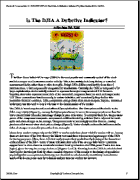V.8:10 (385-387): Is The DJIA A Defective Indicator? by Max Bader, M.D., M.P.H.
Product Description
Is The DJIA A Defective Indicator? by Max Bader, M.D., M.P.H.
The Dow Jones Industrial Average (DJIA) is the most popular and commonly quoted of the stock market averages used to measure market activity. This is due mainly to its long history as a market measurement index rather than to other strengths. Today's DJIA differs considerably from that of previous years, a fact not generally recognized by its adherents. Currently, the DJIA is composed of 30 large-capitalization stocks initially selected to represent the major components of U.S. business.
Together, their sales represent about 20% of the sales of all companies listed on stock exchanges in the U.S. These corporations function mostly in mature industries, and occasionally they decline into borderline financial condition. DJIA components change fairly often due to mergers, buyouts, threatened bankruptcy and the need to keep it relevant to the characteristics of the market.
The DJIA is based on price and is not affected by capitalization. The share prices of the stocks in the DJIA vary widely, causing the higher-priced issues to move the average much more than the lower-priced issues when the percentage change in price is the same. To compute the DJIA, the per-share prices of the component companies are summed and then divided by a divisor that is adjusted for stock splits and other changes in the average. This process leads to increasingly smaller divisors, causing greater market moves when stock prices change. It also abruptly reduces the influence on the DJIA of changes in a stock's price after it has been split.
The Dow Jones Industrial Average (DJIA) is the most popular and commonly quoted of the stock market averages used to measure market activity. This is due mainly to its long history as a market measurement index rather than to other strengths. Today's DJIA differs considerably from that of previous years, a fact not generally recognized by its adherents. Currently, the DJIA is composed of 30 large-capitalization stocks initially selected to represent the major components of U.S. business.
Together, their sales represent about 20% of the sales of all companies listed on stock exchanges in the U.S. These corporations function mostly in mature industries, and occasionally they decline into borderline financial condition. DJIA components change fairly often due to mergers, buyouts, threatened bankruptcy and the need to keep it relevant to the characteristics of the market.
The DJIA is based on price and is not affected by capitalization. The share prices of the stocks in the DJIA vary widely, causing the higher-priced issues to move the average much more than the lower-priced issues when the percentage change in price is the same. To compute the DJIA, the per-share prices of the component companies are summed and then divided by a divisor that is adjusted for stock splits and other changes in the average. This process leads to increasingly smaller divisors, causing greater market moves when stock prices change. It also abruptly reduces the influence on the DJIA of changes in a stock's price after it has been split.
FOR THOSE ORDERING ARTICLES SEPARATELY:
*Note: $2.95-$5.95 Articles are in PDF format only. No hard copy of the article(s) will be delivered. During checkout, click the "Download Now" button to immediately receive your article(s) purchase. STOCKS & COMMODITIES magazine is delivered via mail. After paying for your subscription at store.traders.com users can view the S&C Digital Edition in the subscriber's section on Traders.com.
| Take Control of Your Trading. |
| Professional Traders' Starter Kit |
| All these items shown below only $430! |
| Click Here to Order |



